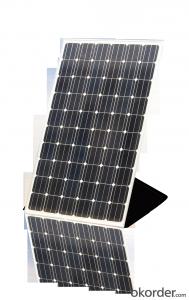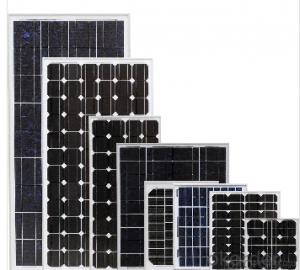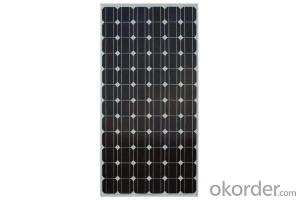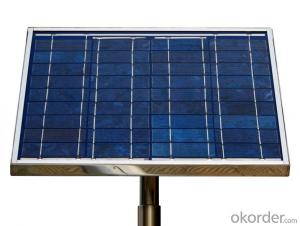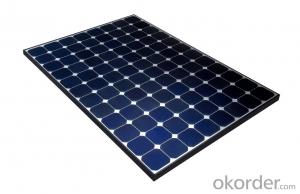Flexi Solar Panels - Mono Solar Panel 280W
OKorder Service Pledge
OKorder Financial Service
You Might Also Like
Product Description:
Details Of Monocrystalline Solar Panel
Product Description of Polycrystalline Solar Panel
EGing PV Solar Monocrystalline Series (270W—285W)
EGing Photovoltaic Technology is a leading internationally recognized vertically intergrated solar PV company.It started silicon ingot production in 2003 and has achieved fast and steady growth since then.EGing has raised capacity to 1GW by the end of 2011 and successfully listed on the Shanghai stock Exchange.With global brand recognition,EGing PV is credited by its global customers a reliable partner.
Characteristics of Polycrystalline Solar Panel
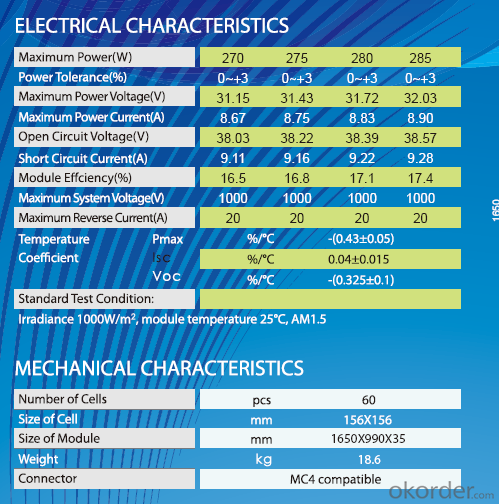
1.performance tolerance: 0~+3%;
2.product guarantee: 10 years
3.Junction Box: EG-TL-BOX026
4.Connector: Original MC4 or MC4 compatible
5.EGing label: 80*120mm
6.Cells: 156*156mm, 220um+/-20um.
7.Series No.: a series number will be stuck to the module underneath the glass. This barcode is the serial number of the module.
8.Frames: Aluminum, 1650*990*35mm. The frames of all delivered modules within this contract must be identical.
9.Frames mounting holes: All modules delivered within this contract, will have the holes for mounting of the modules at the same planned intervals.
10Glass: All modules delivered within this contract will have the same type of glass in functional and optical regards.
Size: 1650*990*35mm
- Q: Can solar panels be connected to the grid?
- Yes, solar panels can be connected to the grid through a process called grid-tie or grid-connected system. This allows excess electricity generated by the solar panels to be fed back into the grid, reducing reliance on traditional power sources and potentially earning credits or payments from the utility company.
- Q: If a solar panel (using 36 3x6 solar cells) puts out 60 watts, how many panels would I need (for a house) if I use a max of 2300 kWh in a month? I checked my electric usage for the past 2 years and the kWh is usually lower but I wanted to use the most kWh used (2300) for my question. Thanks!
- The latter one has some strategies to consider for cutting your power consumption even more by timing your freezers and refrigerators..
- Q: Can solar panels be installed on churches or religious buildings?
- Yes, solar panels can be installed on churches or religious buildings. In fact, many religious institutions have embraced solar energy as a sustainable and cost-effective solution to reduce their carbon footprint and lower energy bills. Installing solar panels on churches not only aligns with their commitment to environmental stewardship but also allows them to set an example for their community by promoting clean energy and sustainability.
- Q: if so, would it be possible to make (or remake) an organism that could subsist off of sunlight and external heat like plants?
- There are, in fact, protozoa that use chlorophyll to harvest sunlight, but the thing is, they also MOVE. So it's not entirely unreasonable that an animal cell could do the same.
- Q: I have an inverter and a battery 20 Amperes.Daily sun shine approx. 7 Hours.Do I need to buy anything or should I connect the solar panel to the Battery direct?
- No, don't connect the panel directly to the battery. You need to isolate the solar panel charging output from the AC-powered charger. A couple of high-current diodes arranged with their anodes connected to the charging sources in the positive supply line will allow either the charger or the solar panel to lift the voltage high enough to charge the battery, albeit with about 0.6 volts dropped across the diode. Both cathode ends would be connected to the battery. This arrangement allows a positive current to flow from either or both charging sources at the same time, although in practice, one will generally be higher than the other. Also, if the AC charger's voltage is significantly higher than the solar panel, the charger may always charge the battery. You would need to regulate its output to be slightly lower than the solar panel when it's near it's minimum useful operating voltage. (note that the 0.6 forward bias voltage on the diode might prevent the solar panel from completely charging the battery if it has any voltage regulation on its output)
- Q: What specification of solar panel would I need to power a laptop every day? I would need to use it for about 0 hours or so every day. I don't know anything about solar panels, but I am seriously thinking of getting one now and don't know who to ask.
- I okorder / says they have DC to DC solutions from 2 V for most laptops.
- Q: Can solar panels be used in areas with high levels of snowfall?
- Yes, solar panels can still be used in areas with high levels of snowfall. While snow accumulation on the panels can temporarily reduce their efficiency, modern solar panel designs and technologies have improved to withstand heavy snow loads. Additionally, the angle at which solar panels are installed and their smooth surface can help snow easily slide off, allowing them to continue generating electricity even in snowy conditions.
- Q: How do solar panels affect the roof warranty?
- Solar panels typically have a minimal impact on the roof warranty. Most reputable solar panel installation companies ensure that the panels are installed in a way that does not void the roof warranty. However, it is always recommended to review the terms and conditions of the roof warranty and consult with the manufacturer or installer to confirm any potential implications before installing solar panels.
- Q: i was reading the popular science magazine and i saw that they might make a Sun Powered it Absolutely NOT possible to make a car with a Solar Panel? I dont see any harm in making it..
- Sailboats typically run on wind; hence, Sailboat. I haven't read your article on it though; but, I would think that the solar power would be for the battery powered stuff and possibly a little motor for it. For a car... There are competitions, right now for solar cars. Only they are very light and don't really go that fast. The panels tend to be large and weight a bit more than one would think. I don't understand why they can't simply make a car generate power simply by the rotation of the wheels itself. They could take a hybrid, take out the gasoline portion and it would simply recharge the batteries by the friction of the turning wheels.
- Q: I am doing a school project and we need to find the cost of solar panels for our school. The problem is i don't know what size the system needs to be. Is it 000 watts or 000000 watts?Also can you find the cost of the system?Thanks
- Good question I am uncomfortable doing my child's homework so I will not complete the assignment for you. I am also always willing to help. Having the kWh is a great start. You must also ask the question when you size a system is there any way to reduce this load. Each kWh that you do not have to produce saves significant cost to the system. Next what type of system grid tied or off grid the two systems will have very different size needs and overall cost. I googled PV system sizing and got the below link. at first glance I like it. You can do the same for system cost. I also included a trade link for your review factors in sizing system type amount of bill offsetting geographic location site location track mounted or fixed and more Should you need additional help you can email me I will not do your work for you but I can either verify it or point you in the right direction
Send your message to us
Flexi Solar Panels - Mono Solar Panel 280W
OKorder Service Pledge
OKorder Financial Service
Similar products
Hot products
Hot Searches
Related keywords
